MCQ’S
I. Choose the correct answer from the given options.
1. The CGS unit of moment of force is :
(a) dyne-m
(b) N-cm
(c) N-m
(d) dyne-cm
Ans. (d) dyne-cm
2. The point of action of force on a rigid body is
(a) fixed point on rigid body
(b) fixed point, but can be transferred anywhere along the line of action of force
(c) fixed point, but can be transferred anywhere along the direction of force
(d) fixed point, but can be transferred anywhere opposite to the direction of force
Ans. (b) fixed point, but can be transferred anywhere along the line of action of force
3. The moment of couple is mathematically the
(a) product of one force and the perpendicular distance between two forces
(b) product of both forces and the perpendicular distance between them
(c) product of one force and the perpendicular distance between the point of application of force and turning point.
(d) none of these
Ans. (a) product of one force and the perpendicular distance between two forces
4. The centre of gravity of a cricket ball is at
(a) its geometric centre
(b) its bottom touching the ground
(c) its top-most point
(d) any point on its surface
Ans. (a) its geometric centre
5. A solid body can be balanced by supporting at its
(a) mid-point
(b) geometric centre
(c) centre of gravity
(d) none of these
Ans. (c) centre of gravity
6. If the displacement is normal to the direction of force, then work done is :
(a) positive
(b) negative
(c) zero
(d) none of these
Ans. (c) zero
7. An energy of 4 kJ causes a displacement of 64m in 2.5s. Then force and power are
(a) 62.5 N and 1600 W
(b) 6.25 N and 160 W
(c) 625 N and 1600 W
(d) 62.5 N and 160 W
Ans. (a) 62.5 N and 1600 W
8. On doubling the velocity of a body, its kinetic energy becomes :
(a) half
(b) twice
(c) four times
(d) none of these
Ans. (c) four times
9. In an electric cell while in use, the change in energy is from
(a) electrical to chemical
(b) electrical to mechanical
(c) chemical to electrical
(d) chemical to mechanical
Ans. (c) chemical to electrical
10. The energy conversion taking place in a loud speaker is
(a) from light energy to sound energy
(b) from electric energy to sound energy
(c) from sound energy to electric energy
(d) none of these
Ans. (b) from electric energy to sound energy
11. The resistive or opposing force overcome by a machine is called the :
(a) load
(b) fulcrum
(c) effort
(d) none of these
Ans. (a) load
12. The loss of energy in an actual machine due to:
(a) the moving parts in it are neither weightless nor smooth
(b) the string in it is not perfectly elastic
(c) its different parts are not perfectly rigid
(d) all of these
Ans. (d) all of these
13. A machine in which displacement of load is less than the displacement of effort, such a machine
(a) gives the gain in speed
(b) acts as a force multiplier
(c) generally changes the direction of effort
(d) none of these
Ans. (b) acts as a force multiplier
14. The point at which the energy is supplied to a machine by applying the effort is called the :
(a) load point
(b) pivot
(c) effort point
(d) none of these
Ans. (c) effort point
15. Which of the following levers does always act as a speed multiplier?
(a) Lever of first order
(b) Lever of second order
(c) Lever of third order
(d) Any one of these
Ans. (c) Lever of third order
16. During sunrise or sunset, the sun appears bigger because the rays of light coming from it pass through:
(a) larger length of the atmosphere
(b) smaller length of the atmosphere
(c) the earth gets closer to the sun
(d) none of these
Ans. (a) larger length of the atmosphere
17. When an equilateral prism is in minimum deviation position the angle of incidence is :
(a) greater than angle of emergence
(b) smaller than the angle of emergence
(c) equal to the angle of emergence
(d) none of these
Ans. (c) equal to the angle of emergence
18. A stone placed at the bottom of a water tank appears raised by 80 cm. If the refractive index of water is 4/3, then the actual depth of water in the tank is:
(a) 300 cm
(b) 310 cm
(c) 320 cm
(d) 330 cm
Ans. (a) 300 cm
19. The device that has been used by a person to read small letters is a
(a) convex lens
(b) concave lens
(c) prism
(d) convex mirror
Ans. (a) convex lens
20. A lens forms the image of an object placed at a distance 15 cm from it, at a distance 60 cm in front of it. The focal length of the lens is
(a) 10 cm
(b) 15 cm
(c) 12 cm
(d) 25 cm
Ans. (c) 12 cm
21. The practical application based on the reflection of sound is :
(a) megaphone
(b) sounding board
(c) sonometer
(d) both (a) and (b)
Ans. (d) both (a) and (b)
22. The ultasonic waves are more energetic than the
(a) audible sound
(b) infrasonic sound
(c) both (a) and (b)
(d) none of these
Ans. (c) both (a) and (b)
23. Two notes are produced from a flute and piano, such that they have same loudness and same pitch. The notes so produced differ in their :
(a) waveform
(b) wavelength
(c) frequency
(d) speed
Ans. (a) waveform
24. Resonance is a special case of:
(a) natural vibrations
(b) free vibrations
(c) damped vibrations
(d) forced vibrations
Ans. (d) forced vibrations
25. Sound waves can not pass through:
(a) helium gas
(b) vacuum
(c) air
(d) metallic iron
Ans. (b) vacuum
26. Which of the following is non-ohmic resistance?
(a) Copper wire
(b) Brass wire
(c) Copper wire wound on an electromagnet
(d) Constantan wire
Ans. (c) Copper wire wound on an electromagnet
27. In a series circuit :
(a) p.d across all resistors is same
(b) current flowing through all resistors is same
(c) the combined resistance of all resistors is less than individual resistors
(d) none of these
Ans. (b) current flowing through all resistors is same
28. The electric current flows through a liquid when :
(a) cations migrate towards cathode in the liquid and discharge
(b) anions migrate towards anode in the liquid and discharge
(c) simultaneous movement of cations and anions in the opposite directions within liquid and their discharge at electrodes
(d) none of these
Ans. (c) simultaneous movement of cations and anions in the opposite directions within liquid and their discharge at electrodes
29. When a cell is in a closed electric circuit, the potential difference between its electrodes is called :
(a) drop in potential
(b) electromotive force
(c) terminal voltage
(d) none of these
Ans. (c) terminal voltage
30. Which one is non-ohmic resistance?
(a) constantan wire
(b) electric bell
(c) coil in heater
(d) eureka wire
Ans. (b) electric bell
31. Kilowatt hour and kilowatt are:
(a) SI units of power and electric energy
(b) commercial units of power and electric energy
(c) SI units of electric energy and power
(d) commercial units of electric energy and power
Ans. (d) commercial units of electric energy and power
32. In a three pin plug the live pin is :
(a) thinner and is toward left
(b) thicker and is towards left
(c) thinner and is towards right
(d) thicker and is towards right
Ans. (c) thinner and is towards right
33. Which is not used for heating element of a heating appliances?
(a) Constantan wire
(b) Tungsten wire
(c) Eureka wire
(d) Manganin wire
Ans. (c) Eureka wire
34. A heater draws a current of 5A at 220V for 2 minutes. The energy released by heater in kilojoules is:
(a) 132 kJ
(b) 66 kJ
(c) 99 kJ
(d) 33 kJ
Ans. (a) 132 kJ
35. An electric device consumes 5760 J of energy in 1.0 minute, when the p.d. at its ends is 24V. The electrical resistance of the device is :
(a) 4.5 Ω
(b) 5 Ω
(c) 6 Ω
(d) 5.5 Ω
Ans. (c) 6 Ω
36. In an electric motor :
(a) mechanical energy changes to heat energy
(b) mechanical energy changes to electric energy
(c) electric energy changes to mechanical energy
(d) electric energy changes to magnetic energy
Ans. (c) electric energy changes to mechanical energy
37. Which is not the property of magnetic lines of force around a circular coil carrying current?
(a) The lines of force are parallel at the points where the current enters or leaves.
(b) Within the space enclosed by the coil the lines of forces are in same direction.
(c) Near the centre of coil the lines of forces are almost parallel.
(d) With the increase in strength of current in coil, the number of magnetic field lines increases.
Ans. (a) The lines of force are parallel at the points where the current enters or leaves.
38. The power of electromagnet can be increased :
(a) by winding solenoid coil over soft and laminated piece of iron
(b) by increasing magnitude of current in the coil of solenoid
(c) by increasing number of turns in the solenoid
(d) all of these
Ans. (d) all of these
39. An a.c. generator converts
(a) mechanical energy into heat energy
(b) mechanical energy into electric energy
(c) electric energy into mechanical energy
(d) electric energy into magnetic energy
Ans. (b) mechanical energy into electric energy
40. Step down transformers are used
(a) at power sub-stations.
(b) with mobile phones
(c) with computers
(d) all of these
Ans. (d) all of these
41. Land and sea breezes are formed in coastal regions because:
(a) water has very high specific heat capacity than the land.
(b) land has very high specific heat capacity than the water
(c) sea water cools the cooler regions.
(d) all of the above.
Ans. (a) water has very high specific heat capacity than the land.
42. Heat energy is :
(a) sum total of K.E. of the molecules of matter only.
(b) sum total of P.E. of the molecules of matter only.
(c) sum total of kinetic and potential energies of all the molecules.
(d) none of these.
Ans. (c) sum total of kinetic and potential energies of all the molecules.
43. The flow of heat energy from one body to another body is determined by
(a) the amount of heat contained in the bodies
(b) the temperature difference between the bodies
(c) the mass of the bodies
(d) none of these
Ans. (b) the temperature difference between the bodies
44. The land and sea breezes are caused due to:
(a) high heat capacity of water
(b) high specific heat capacity of water
(c) difference between specific heat capacities of water and land
(d) both (b) and (c)
Ans. (d) both (b) and (c)
45. When land breeze blows:
(a) it always blows during night.
(b) the cold and heavy air from land blows towards sea.
(c) the warm and light air above the sea rises up and blows towards land.
(d) all of these.
Ans. (b) the cold and heavy air from land blows towards sea.
46. The atoms of same element having same atomic number, but different atomic masses are called:
(a) isotopes
(b) isobars
(c) isotones
(d) both (a) and (b)
Ans. (a) isotopes
47. The atoms of different elements having same mass number, but different atomic numbers are called :
(a) isotopes
(b) isotones
(c) isobars
(d) none of these
Ans. (c) isobars
48. During B-emission an electron is ejected from the atom of radioactive substance. The electron is ejected from the :
(a) outermost orbit of atom
(b) innermost orbit of atom
(c) nucleus of the atom
(d) none of these
Ans. (c) nucleus of the atom
49. Atoms of different elements having same number of neutrons, but different atomic numbers are called:
(a) isotopes
(b) isobars
(c) isotones
(d) none of these
Ans. (c) isotones
50. A beam of beta particles is subjected to a strong magnetic field. The beta particles are :
(a) strongly deflected towards south pole
(b) weakly deflected towards south pole
(c) weakly deflected towards north pole
(d) not deflected at all
Ans. (a) strongly deflected towards south pole
Short Answer Type Question
1. Define the following:
(a) Rigid body
(b) Principal of transmissibility of force
Ans. (a) Rigid body: Rigid body is a body which does not deform under application of an external force.
(b) Principle of transmissibility of force – The point of action of force can be transmitted anywhere along the line of action of force, without causing any material difference in the movement of the body
2. Explain the following
(a) Why does a jack screw provided with a long arm?
(b) It is easier to turn a steering wheel of larger diameter than a steering wheel of small diameter.
Ans. (a) The long arm of the jackscrew acts as the perpendicular distance between the line of action of force and the axis of rotation. This generates maximum moment of force for a minimum effort applied.
(b) Steering wheel of a larger diameter ensures maximum perpendicular distance between the line of action of force and the axis of rotation. This helps in turning the steering wheel with minimum effort.
3. With reference to magnitude of force and its direction, how does centripetal force differ from centrifugal force?
Ans. Centripetal force is directed towards the centre of the circular path of a rotating body. Whereas centrifugal force is directed away from the centre along the radius of its circular path. The magnitude of centripetal force is same as that of the centrifugal force.
4. (a) State the absolute unit of power in SI system.
(b) What is horse power? What is its magnitude in SI unit?
Ans. (a) Unit of power in SI system is watt.
(b) Horse power is a bigger unit of power. 1 HP = 746 W (in SI unit).
5. Define work and discuss when the work done is maximum and when it is zero.
Ans. Work is said to be done only when the force applied on a body causes a displacement of the body in the direction of force or any resolved component of the force. The work is maximum, when displacement is in the direction of applied force. The work done is minimum when displacement is zero or displacement is normal to the direction of the applied force.
6. Give example of:(a) When heat energy changes into kinetic energy.
(b) When sound energy changes into electric energy.
Ans. (a) In heat engines, the heat energy changes to kinetic energy.
(b) Microphone
7. Define the following terms with reference to a machine:
(a) Total load
(b) Actual mechanical advantage
(c) Velocity ratio
Ans. (a) Total load is the sum of load lifted by the machine and the load due to friction and movable parts of machine.
(b) Actual mechanical advantage is the ratio between the useful load moved to the effort applied.
(c) Velocity ratio is the ratio of the distance traversed by the effort to the distance traversed by the load in the same time.
8. Explain, why a machine can not be 100% efficient?
Ans. A machine can never be 100% efficient because:
(a) a part of the input is wasted in moving the parts of the machine.
(b) a part of the input is wasted in overcoming friction between the moving parts.
9. What is the principle of lever?
Ans. When a lever is in equilibrium, the clockwise moments of the load about the fulcrum is equal to the anticlockwise moment of the effort about the fulcrum, provided the lever is weightless and offers no friction.
10. (a) Define critical angle.
(b) State one important factor which affects the critical angle of a given medium.
Ans. (a) Critical angle: Angle of incidence in a denser medium for which the angle of refraction in the rarer medium is 90° is called critical angle.
(b) The colour (or wavelength) of light.
11. (a) Define refractive index of a medium in terms of velocity of light.
(b) Can the absolute refractive index of a medium be less than one?
Ans. (a) Refractive index of a medium is the ratio of velocity of light in vacuum or air to the velocity of light in a given medium.
(b) Yes, when a ray travels from glass (or any denser medium) to air, the absolute refractive index of air is less than 1.
12. Write the names of all the components of electromagnetic spectrum in the order of increasing frequency.
Ans. The components of electromagnetic spectrum in the order of increasing frequency are: Radio waves, television waves, microwaves, infrared rays, visible light, ultraviolet light, X-rays and gamma rays.
13. What are reverberation? Give two examples.
Ans. When series of reflected sound from the different reflectors fall on the ears one after another, thereby giving rise to a rolling sound is called reverberation. Reverberation are heard in big halls or the hills in a closed valley.
14. How do bats locate their prey? Explain in detail.
Ans. Bats can produce and detect the sounds of very high frequency. The sound produced by the bats gets reflected back from obstacles. By detecting the echoes, bats come to know the position of the obstacles, even in the dark. This helps them to fly skilfully, and locate their prey as well.
15. (a) Give one example of resonance.
(b) What are acoustically measurable quantities related to pitch and loudness?
Ans. (a) If two pendulums of same length are suspended from a string and one pendulum is made to vibrate, the other pendulum also starts vibrating with a large amplitude and in same phase because of resonance.
(b) Frequency and amplitude are acoustically measurable quantities related to pitch and loudness.
16. (a) State Ohm’s law.
(b) What are the limitations of Ohm’s law?
Ans. (a) According to Ohm’s law, the current flowing through a conductor is directly proportional to the potential difference across its ends, provided the physical conditions of the conductor remains the same.
(b) Certain resistors such as diodes, triodes, semiconductors, do not obey Ohm’s law. For these resistors, the V-I graph is not a straight line. Also, Ohm’s law is valid as long as the temperature of the conductor is constant.
17. (a) In which direction conventional current and electronic current flow from a source of electricity?
(b) Name two materials whose resistance remains the same with the rise in temperature.
Ans. (a) Conventional current flows from higher potential (positive terminal) to a lower potential (negative terminal). Electronic current flows from lower potential to a higher potential i.c., from negative terminal to positive terminal.
(b) Manganin, constantan
18. Define quantity of charge. States its practical unit and define it.
Ans. The number of charges which drift from a higher to a lower potential is called quantity of charge. The unit of quantity of electric charge is coulomb (C). 1 C is the quantity of electric charge which will deposit 0.00118 g of silver on the cathode, when passed through silver nitrate solution.
19.. Of the three connecting wires in a household circuit:
(a) Which two of the three wires are at the same potential?
(b) In which of the three wires should the switch be connected?
Ans. (a) Neutral and Earth wires are at the same potential.
(b) Switch should be connected in live wire only and that too before the appliance.
20. Which of the two wires amongst copper or nichrome would you use for the element of an electric heater? Give reasons to justify your answer.
Ans. Nichrome wire is used as an element of electric heater on account of the following reasons:
(a) It offers appreciable resistance as compared to copper wire.
(b) It does not get oxidised till 1000°C.
21. (a) Name the colour code of the wire which is connected to the metallic body of an appliance.
(b) Why is it not advisable to use a piece of copper wire as fuse wire in an electric circuit?
Ans. (a) The wire connected to the metallic body of an electrical appliance is green or yellow in international standards.
(b) Copper has high melting point and very low resistance but a fuse wire should have low melting point and high resistance. So, it is not advisable to use a piece of copper wire as fuse wire in an electric circuit. It is because it is not likely to melt during short circuit.
22. (a) When can an electric charge give rise to a magnetic field?
(b) A wire bent into a circle, carries current in an anticlockwise direction. What polarity does this face of coil exhibit?
Ans. (a) When electric charge is in motion i.e., charge flows, it gives rise to magnetic field
(b) The face of the coil will exhibit north polarity.
23. (a) What is a solenoid?
(b) How can you demagnetise a bar magnet by employing alternating current?
Ans. (a) Solenoid is an insulated copper coil, wound on cylindrical cardboard such that its length is greater than its diameter and it behaves like a magnet when electric current is made to flow through it.
(b) Place the bar magnet in a long and thin cardboard tube, over which is wound an insulated copper coil of many turns. Connect the coil to an A.C. source through a switch. Point the coil in east-west direction and switch on the current for few seconds. The bar magnet will get demagnetised.
24. (a) At what voltage is current available in our household?
(b) How is the magnetic field due to a straight current carrying wire affected if current in the wire is decreased?
(c) How is the magnetic field due to a straight current carrying wire affected if current in the wire is reversed?
Ans. (a) 220 V in India.
(b) The magnetic field due to a straight current carrying wire decreases.
(c) The magnetic field due to a straight current carrying wire reverses.
25. Why should bits of ice be wiped dry before adding them to the calorimeter during the determination of specific latent heat of fusion of ice?
Ans. If ice is not wiped dry, then it may increase the mass of water and there will be an error in the calculation. Also, specific heat capacity of ice is different from water, which also introduces error in the determination of latent heat of fusion of ice.
26. (a) Define calorimetry.
(b) Name the material used for making a calorimeter.
(c) Why is a calorimeter made up of thin sheets of the above material answered in (b)?
Ans. (a) Calorimetry: The branch of physics which deals with the measurement of heat energy is called calorimetry.
(b) Copper material used for making a calorimeter.
(c) The thermal capacity of copper is very low. Thus, it can easily attain the temperature of contents within it, but absorbs negligible amount of heat energy. This reduces experimental error.
27. (a) An equal quantity of heat is supplied to two substances A and B. The substance A shows a greater rise in temperature. What can you say about the specific heat capacity of A as compared to that of B?
(b) Why are burns caused by steam more severe than those caused by boiling water at the same temperature?
Ans. (a) The specific heat capacity of A is less than B.
(b) It is on account of very high specific latent heat of vaporisation of steam. 1 g of steam at 100°C has 2260 J of heat energy more than 1 g of water at 100°C. Thus, steam causes more severe burns than the water at 100°C.
28. When does the nucleus of an atom tend to be radioactive?
Ans. The nucleus of an atom tends to be radioactive when:
(a) its atomic number exceeds 82.
(b) there is an imbalance of protons and neutrons as compared to a normal stable atom.
29. Why can nuclear fusion not be possible to generate electricity?
Ans. Nuclear fusion requires a pressure of millions of atmosphere and millions of degree celsius temperature, which is not possible. Furthermore, there is no material available to withstand such high temperature and pressure in which nuclear fusion can be carried out.
30. (a) What is radioactivity?
(b) What is nuclear fusion?
Ans. (a) Radioactivity is the phenomenon due to which certain elements give out highly penetrating radiations spontaneously.
(b) The process of combining lighter nuclei (atomic weight less than 20) into heavier nuclei with the release of energy, is called nuclear fusion.
Long Answer Type Question
1. (i) Define equilibrium and briefly discuss types of equilibrium.
(ii) Compare uniform circular motion and uniform linear motion.
(iii) Explain the motion of moon around the earth.
Ans. (i) When number of forces (two or more) act on a rigid body, such that it does not changes its state of rest or uniform motion, the rigid body is said to be in equilibrium There can be two kinds of equilibrium i.e.,
(a) Static equilibrium
(b) dynamic equilibrium
(a) Static equilibrium : When a body remains in its state of rest when two or more forces are acting on it then the body is said to be in static equilibrium.
(b) Dynamic equilibrium : When a body remains in its uniform state of motion (translational or rational) when two or more forces are acting on it, the body is said to be in dynamic equilibrium.
(ii) Comparison of uniform circular motion and uniform linear motion –
(iii) The moon moves around the earth in a near circular path. The gravitational force of the earth acts on the moon and provides the necessary centripetal force.
2. (i) (a) What is a pulley?
(b) What is single fixed pulley system? .
(c) What is single movable pulley system?
(ii) A pulley system has five pulleys in all and is 90% efficient. Calculate :
(a) the mechanical advantage
(b) the effort required to lift a load of 1000 N
(c) the resistance due to the movable parts of the machine and friction
(iii) Give reasons why single fixed pulley is commonly used.
Ans. (i) (a) A pulley is a flat circular disc having a groove in its edge and capable of rotating about a fixed point passing through its centre and is commonly called axle.
(b) It consists of a single pulley. It is attached to some high platform and around its groove passes a rope. One end of the rope is attached to the load and the effort is applied at the other end.
(c) It consists of two pulleys A and B. The pulley A is fixed on some high platform, such as a hook in the ceiling. The pulley B is movable, i.e., it moves up and down, along with the load, in addition to rotating around its own axis.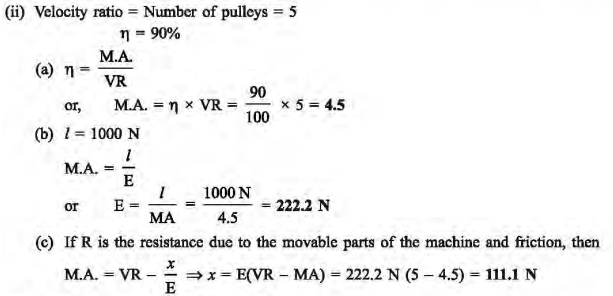
(iii) Reasons for using single fixed pulley:
(a) It is always casier to apply effort in the downward direction rather than in the upward direction. Thus, the pulley helps in changing the direction of effort.
(b) One can use one’s own body weight, while applying the effort in the downward direction.
3. (i) (a) What is a machine?
(b) In reference to machine define effort and actual mechanical advantage.
(ii) Prove that efficiency of a machine is the ratio between mechanical advantage and the velocity ratio.
(iii) A machine displaces a load of 125 kgf through a distance 0.30 m, when an effort of 12.5 kgf acts through a distance of 4.0 m. Calculate the
(a) velocity ratio
(b) mechanical advantage
(c) % age efficiency of the machine
Ans. (i) (a) Machine is a device by which we can overcome large resistance or gain speed or change the direction of effort applied, by applying comparatively a small force at a convenient point, and in a desired direction.
(b) Effort: Effort is the external force applied on a machine to overcome the load or resistance. Actual mechanical advantage: Actual mechanical advantage is the ratio between the useful load moved to the effort applied.
(ii) Consider a machine which displaces a useful load ‘7’ through a distance ‘d’, when an effort ‘E’ causes a displacement through distance D.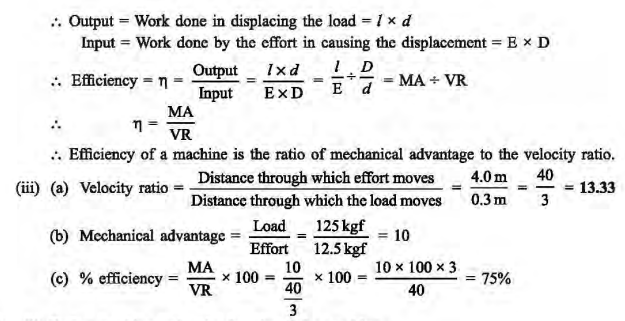
4. To which order do the following levers belong and why?
(i) Railway signal, (ii) a man cutting bread with knife, (iii) a boy writing on a piece of paper, (iv) nut-cracker, (v) handle of water pump, (vi) see-saw, (vii) forceps, (viii) a man rowing a boat, (ix) lock and key, (x) opening of a soda water bottle, (xi) closing a door, (xii) motor car foot brake, (xiii) nail cutter, (xiv) a fishing rod, (xv) a lemon squeezer.
Ans. Levers of Ist order
(i) Railway signal
(ii) Handle of water pump
(iii) See-saw
(iv) Motor car foot brake
(v) Nail cutter
Levers of IInd order
(i) Nut-cracker
(ii) A man rowing a boat
(iii) Lock and key
(iv) Opening of soda-water bottle
(v) A lemon squeezer.
(vi) Closing a door
Levers of IIIrd order
(i) A man cutting bread with knife
(ii) A boy writing on a piece of paper
(iii) Forceps
(iv) A fishing rod
5. (i) (a) State the laws of refraction of light.
(b) Write a relation between the angle of incidence (1), angle of emergence (e), angle of prism (4) and angle of deviation (D) for a ray of light passing through an equilateral prism.
(ii) (a) Suggest one way, in each case, by which we can detect the presence of:
1. Infrared radiations
2. Ultraviolet radiations.
(b) Give one use of infrared radiations.
Ans. (i) (a) Snell’s Law of Refraction: It states: The ratio between the values of the sine of angle incidence and the sine of angle of refraction for two given optical media is a constant quantity.
(b) Angle of incidence (1) + Angle of emergence (e) = Angle of prism (A) + Angle of deviation (D)
Li + Le= ZA + ZD
(ii) (a) 1. Mercury rises rapidly if a blackened bulb thermometer is kept in infrared radiations.
2. Photographic plates get exposed by ultraviolet radiation, even when wrapped in black paper.
(b) Infrared radiations are used in remote control of television and other gadgets.
6. (i) (a) A person is tuning his radio set to a particular station. What is the person trying to do to tune it?
(b) Name the phenomenon involved, in tuning the radio set.
(c) Define the phenomenon named by you in part (b).
(ii) (a) A wire of length 80 cm has a frequency of 256 Hz. Calculate the length of a similar wire under similar tension, which will have frequency 1024 Hz.
(b) A certain sound has a frequency of 256 hertz and a wavelength of 1.3 m.
(i) Calculate the speed with which this sound travels.
(ii) What difference would be felt by a listener between the above sound and another sound traveling at the same speed, but of wavelength 2.6 m?
(iii) Name the factor that determines: (a) Loudness of the sound heard. (b) Quality of the note. (c) Pitch of the note.
Ans. (i) (a) While tuning the radio, the person tries to match the frequency of his radio set with that of the radio station so that a resonance takes place and he hears the sound clearly.
(b) The phenomenon taking place in radio set is electromagnetic resonance.
(c) When the frequency of a given body corresponds to the frequency of the impressed force, the body vibrates with a greater amplitude and the phenomenon is called resonance.
(iii) (a) The square of amplitude of vibrating body determines its loudness.
(b) The waveform of vibrating body determines quality of the note.
(c) The frequency of a vibrating body determines its pitch.
7. (i) (a) Name the characteristic of sound which enables a person to differentiate between two sounds with equal loudness but having different frequencies.
(b) Define the characteristic named by you in (a).
(c) Name the characteristic of sound which enables a person to differentiate between two sounds of the same loudness and frequency but produced by different instruments.
(ii) (a) (i) What are mechanical waves?
(ii) Name one property of waves that do not change when the wave passes from one medium to another.
(b) The diagram shows three different modes of vibration P, Q and R of the same string: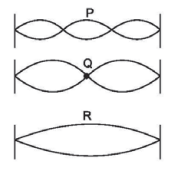
(i) Which vibration will produce a louder sound and why?
(ii) The sound of which vibration will have maximum shrillness?
(iii) State the ratio of wavelengths P and R.
(iii) Write down differences between free vibration and forced vibration.
Ans. (i) (a) The characteristic is called pitch of sound.
(b) The sensation produced in the brain due to the sound of same loudness, but different frequencies are called pitch of sound. Generally, lower frequencies produce bass effect and higher frequencies shrill effect.
(c) The characteristic is called timbre or quality of sound. It depends upon the waveform of the sound.
(ii) (a) (i) The waves produces in matter (solid, liquid or gas) are called mechanical waves.
(ii) The frequency of the waves does not change on passing from one medium to another.
(b) (i) R will produce a louder sound, because loudness increases with the increase in amplitude.
(ii) P will have maximum shrillness, because shrillness increases with the increase in frequency.
(iii) Ratio of wavelengths of P and R is 1 : 3.
8. (i) (a) What is an echo?
(b) State two conditions necessary for the formation of an echo.
(ii) What is sonar? State its principle. How is it used to find the depth of sea?
(iii) How do the following use echoes?
(a) army,
(b) geologist,
(c) medical sciences
Ans. (i) (a) Echo is the sound heard after reflection from a distant obstacle, after the original sound has died off.
(b) Conditions necessary for echo formation: (i) The minimum distance between the source of sound and reflecting object/obstacle should be 17 metres. The size of the obstacle must be larger than the wavelength of sound.
(ii) Sonar stands for Sound Navigation and Ranging and the technique used to measure distances by using ultrasonic waves. To find the depth of an ocean, ultrasonic waves from the ship is sent towards the bottom of the ocean. These waves are then received by a suitable receiver, after reflection from the ocean floor. The distance of the bottom of ocean is calculated by measuring the time interval between the instant when waves are sent and the instant when reflected waves are received. Using the value of velocity of sound in water, the depth of ocean floor can be calculated.
(iii) (a) Army uses echoes to locate the gun positions of the enemy.
(b) Geologists use echoes for mineral prospecting.
(c) Echoes produced by ultrasonic waves are used for imaging internal human organs, such as prostate gland, womb, liver, gall bladder. Such imaging is called ultrasonography. Similarly, echo cardiography is used to take the image of heart.
9. (i) A cell of e.m.f. 1.5 V and internal resistance 1.0 is connected to two resistors of 4.0 2 and 20.02 in series as shown in the figure.
Calculate the :
(a) current in the circuit.
(b) potential difference across the 4.0 ohm resistor.
(c) voltage drop when the current is flowing.
(d) potential difference across the cell.
(ii) In the figure, the ammeter A reads 0.3A shown alongside,
Calculate :
(a) the total resistance of the circuit.
(b) the value of R.
(c) the current flowing through R.
(iii) (a)State Ohm’s law
(b) Name two materials whose resistance decreases when the material is heated.
Ans.
(iii) (a) All physical conditions of a conductor remaining the same, the current flowing through it is directly proportional to potential difference at its ends.
(b) The resistance of carbon and germanium decreases with the rise in temperature.
10. (i) What is Earthing?
(ii) Draw a diagram showing (a) a bulb (b) a heater in a domestic household circuit, showing clearly the position of fuse, live wire, neutral wire and switches.
(iii) An electric circuit operating at 250 V has the following appliances connected in parallel and the energy cost Rs5.40 per kVAh. Calculate the monthly bill of a month of 30 days.
(a) 4 bulbs of 100 W each working 8 hours a day.
(b) Two room heaters of resistance 50 2 each, working 2 hours a day.
(c) Two air conditioners drawing current of 8 A, working 6 hours a day.
Ans. (1) By earthing we mean that the metal body of the appliance is connected to a thick copper wire, which is buried deep in the earth and its other end is connected to a copper plate surrounded by a mixture of charcoal and common salt. The earth can be regarded as an electric sink, i.e., it can receive any amount of electrons, but its potential remains zero.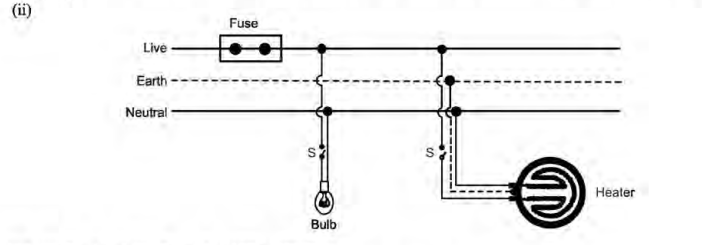
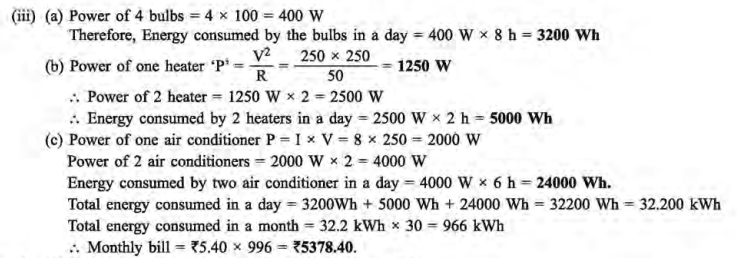
11. (i) What is fuse? Write its characteristics.
(ii) Calculate p.d. at the ends of a power source which, supplies current to a 4 ohm resistance wire for 20 minutes and raises the temperature of 400 g of water through 20°C. [specific heat capacity = 4.2 Jg-1°C-1]
(iii) (a) What do you understand by term electric power?
(b) of the three connecting wires in a household circuit:
(i) Which two of the three wires are at the same potential?
(ii) In which of the three wires should the switch be connected?
Ans. (i) Fuse is a safety device in an electric circuit. It is the weakest point in an electric circuit, which melts and breaks the electric circuit, when the circuit gets
(a) overloaded due to large withdrawal of current,
(b) due to short circuiting in the electric circuit
(c) due to fluctuation of current in the power supply system. Characteristics of Fuse:
(a) It has a low melting point. Generally, a fuse wire is made from an alloy of 50% lead and 50% tin which melts around 200°C.
(b) It has a high resistance, such that its temperature rises rapidly as compared to the connecting copper wires. Thus, when the current exceeds certain limits, it melts.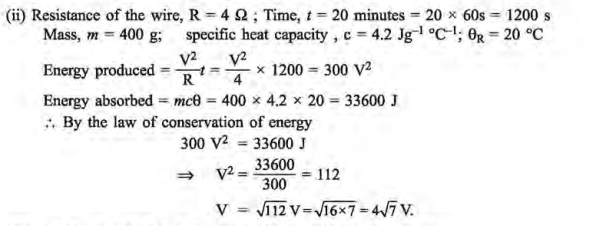
(iii) (a) The rate of doing electric work is called electric power.
(b) (i) Neutral and Earth wires are at the same potential.
(ii) Switch should be connected in live wire only and that too before the appliance.
12. (a) What is an electric generator?
(b) Draw a neat and labelled diagram of a.c. generator?
(c) What is the effect of increasing the speed of rotation of coil in a generator?
(d) What energy conversion takes place in a generator?
(e) What is the magnitude of e.m.f. induced in the coil, when its plane becomes parallel to magnetic field?
Ans. (a) A device which converts mechanical energy into electric energy is called electric generator.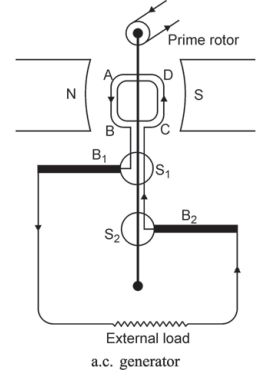
(b) Shown in the figure above.
(c) It increases the magnitude of induced e.m.f.
(d) The mechanical energy is converted into electric energy.
(e) The magnitude of induced e.m.f. is maximum as maximum number of magnetic lines of force cut through the coil.
13. (i) (a) Name the kind of reactions taking place:
(i) In the star (ii) In nuclear reactor (iii) In our body.
(b) When an alpha particle gains two electrons it becomes neutral and becomes an atom of an element which is rare gas. What is the name of this rare gas?
(ii) State three precautions in the handling of radioactive substances.
(iii) (a) Define radioactivity.
(b) What happens inside the nucleus that causes the emission of a beta particle?
(c) Express the above change in the form of an equation.
Ans. (i) (a) (i) Fusion of hydrogen to helium takes place in stars.
(ii) Fission of uranium takes place in nuclear reactors.
(iii) Bio-chemical reaction takes place in our body.
(b) Helium gas
(ii) (a) Radioactive materials should never be handled with bare hands.
(b) One must wear protective suit in handling radioactive material.
(c) Radioactive materials should be stored in thick lead containers.
(iii) (a) The phenomenon due to which certain substances decay on their own by emitting alpha particles, or beta particles or gamma rays is called radioactivity.
(b) A neutron decays inside the nucleus into an electron and proton. The proton is retained by the nucleus, but the electron is ejected out as beta particle.
14. (i) An atomic nucleus A is composed of 84 protons and 128 neutrons. The nucleus A emits an alpha particle and is transformed into a nucleus B.
(a) What is the composition of B?
(b) The nucleus B emits a beta particle and is transformed into a nucleus C. What is the composition of C?
(c) What is mass number of the nucleus A?
(d) Does the composition of C change if it emits gamma radiations?
(ii) (a) Define fusion.
(b) Define fission.
(iii) (a) What is meant by Radioactivity?
(b) What is meant by nuclear waste?
(c) Suggest one effective way for the safe disposal of nuclear waste.
Ans.
(ii) (a) The process of combining lighter nuclei (atomic weight less than 20) into heavier nuclei with the release of energy is called nuclear fusion.
(b) The process by which a heavy radioactive nucleus is broken into light nuclei by the bombardment of slow neutrons, so as to liberate energy and more neutrons than used for bombardment is called nuclear fission.
(iii) (a) The phenomenon due to the nucleus of certain elements decays on its own, giving out harmful radiations, such as alpha particles, beta particles and gamma radiations is called radioactivity.
(b) The residual material left in the nuclear reactors after generating heat energy is called nuclear waste. The nuclear waste is radioactive and very harmful to the environment.
(c) The nuclear waste should be stored in stainless steel containers, lined from within with thick sheets of lead, so that no radioactive rays come out of it. The containers should be stored in safe and well-guarded place, so that they do not fall in the hands of criminal elements.
15. (i) (a) Represent the change in the nucleus of a radioactive element when a ẞ particle is emitted.
(b) What is the name given to elements with same mass number and different atomic number?
(c) Under which conditions does the nucleus of an atom tend to be radioactive?
(ii) (a) State one harmful effect of the radioactivity.
(b) Name the radioactive radiations which have the least penetrating power.
(c) Give one use of radio isotopes.
(d) What is meant by background radiation?
(iii) The ore of Uranium found in nature contains 238/92U and 235/92U. Although both the isotopes are fissionable, it is found out experimentally that one of the two isotopes is more easily fissionable.
(a) Name the isotope of Uranium which is easily fissionable.
(b) Give a reason for your answer
(c) Write a nuclear reaction when Uranium 238 emits an alpha particle to form a Thorium (Th) nucleus.
Ans. (i) (a) zXA →Z+1XA 1+ -1e0
(b) Isobars.
(c) The nucleus of an atom tend to be radioactive :
1. When its atomic number exceeds 82.
2. There is an imbalance of protons and neutrons as compared to normal stable atom.
(ii) (a) The radiations given out in the decay process can damage living tissues.
(b) Alpha radiations have least penetrating power.
(c) Radio isotopes are used in the cure of cancer.
(d) Radiation which is omnipresent and can be detected of Geiger Muller tube is called background radiation.
(iii) (a) 235/92U is easily fissionable.
(b) 235/92U fissions with low-energy thermal neutrons because the binding energy resulting from the absorption of a neutron is greater than the critical energy required for fission.
(c) 92U238→ 90Th234+ Alpha particle (2He4)
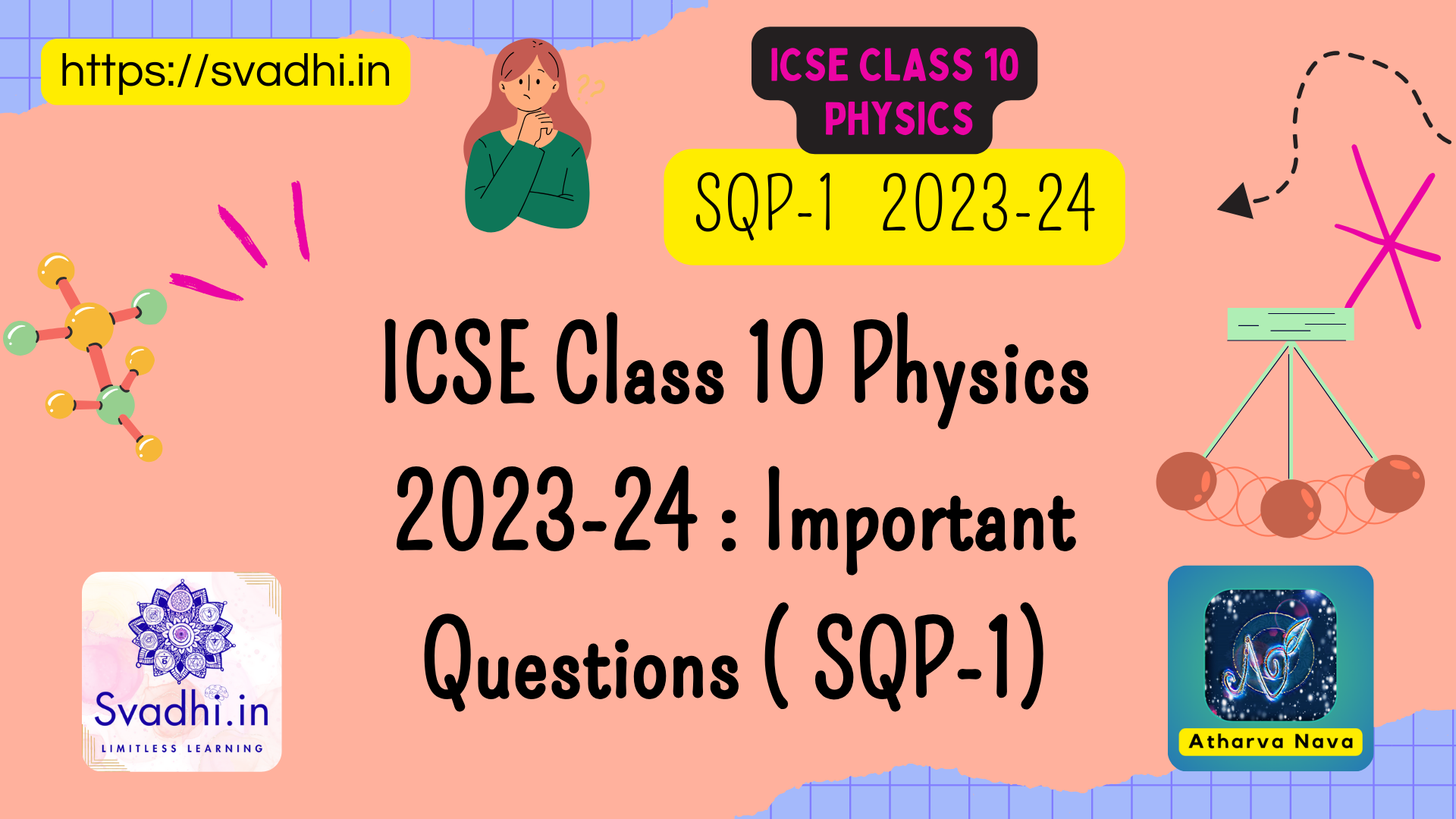
Comments are closed